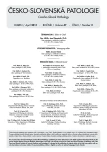The origin, distribution and relocability of supravital hemorrhages
Authors:
P. Strejc 1; A. Pilin 1; P. Klír 2; D. Vajtr 1
Authors‘ workplace:
Ústav soudního lékařství 1. lékařské fakulty UK, Praha
1; Subkatedra soudního lékařství IPVZ, Praha
2
Published in:
Soud Lék., 56, 2011, No. 2, p. 18-20
Category:
Original Article
Overview
The hemorrhage as a result of intravital bleeding is considered, from forensic point of view, as important sign of vital reaction of injury. However, in special cases it must be accepted that hemorrhage occurred after the death. The formation of supravital changes is evident e.g. in organ donors whose blood circulation and pulmonary ventilation is kept after the brain death. The post-mortem origin of hemorrhages can also be seen in donors of eyeballs after enucleation made before the autopsy at Institute of Forensic Medicine and Toxicology. These hemorrhages are manifested after several hours when eyeballs were removed.
Moreover, we observed the origin of hemorrhage in orbit which was caused nor by intravital bleeding neither by direct force. Its origin could not be explained nothing but postmortem propagation of the hemorrhage from the fracture of anterior fossa of the scull base. We did not find information about postmortem origin or relocation of hemorrhage of such extent in the literature. In the frame of knowledge about supravital reaction, this finding is of general importance with forensic impact. The documentation from the scene of death allowed correcting the appreciation of the mechanism of injury and traumatic process from the point of view of foreign culpability which should be considered in such case (e.g. a blow to the orbit with following fall under passing subway train).
Keywords:
vital and supravital reaction – postmortal hematoma propagation – forensic value
Sources
1. Dreßler J, Bachmann L, Strejc P, Koch R, Müller E. Expression of Adhesion Molecules: Diagnostic value in Legal Medicine. Rechtsmedizin 1999; 9: Suppl. I, A 14 : 0–39.
2. Dreßler J, Strejc P, Müller E, Boubelík 0, Grossová I. K expresi adhezivních bílkovin v poraněné lidské kůži a v experimentu na myších. Expression of adhesion proteins in injured skin of mouse and human. Labor Aktuell CS 2001; 1 : 10–14
3. Dreßler J, Strejc P, Klír P, Müller E, Boubelík 0, Grossová I. K časovým relacím exprese adhezivních bílkovin a dalších markerů stáří poranění. Soud Lek 2002; 47(3): 38–42.
4. Klír P, Toupalík P, Bouška I, Ježková J. Využití glycophorinu v soudním lékařství.Soud Lek 2000; 45(2): 22–25.
5. Madea B, Brinkmann B. Handbuch gerichtliche Medizin 1. Berlin: Springer Verlag; 2003 : 1344.
6. Ortiz-Rey JA, Suárez-PeĖaranda JM, San Miguel P, MuĖoz I, Rodríguez-Calvo MS, Concheiro L. Immunohistochemical analysis of P-Selectin as a possible marker of vitality in human cutaneous wounds. Journal of Forensic and Legal Medicine 2008; 15(6): 368–372.
Labels
Anatomical pathology Forensic medical examiner ToxicologyArticle was published in
Forensic Medicine

2011 Issue 2
Most read in this issue
- The origin, distribution and relocability of supravital hemorrhages
- Homicide, suicide or fatal accident?
- Morfologické změny v kůži krku u osob, které spáchaly sebevraždu oběšením
- Breath alcohol analysis
